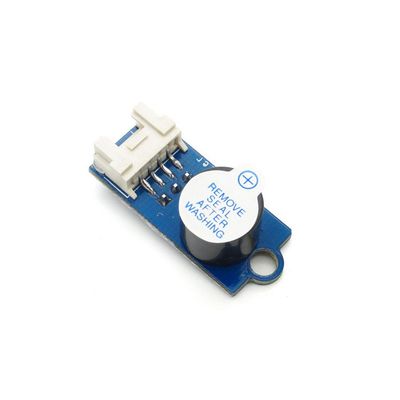Difference between revisions of "Buzzer"
(→Demo) |
(→Download) |
||
| Line 66: | Line 66: | ||
delay(1000); // wait for a second | delay(1000); // wait for a second | ||
} | } | ||
| + | |||
| + | ==Library== | ||
| + | |||
| + | [https://code.google.com/p/tone-itead/ Tone Generator Library For Buzzer Electronic Brick] | ||
| + | |||
==Download== | ==Download== | ||
==Useful Links== | ==Useful Links== | ||
Revision as of 08:32, 27 May 2014
Contents
Overview
What is an electronic brick? An electronic brick is an electronic module which can be assembled like Lego bricks simply by plugging in and pulling out. Compared to traditional universal boards and circuit modules assembled with various electronic components, electronic brick has standardized interfaces, plug and play, simplifying construction of prototype circuit on one’s own. There are many types of electronic bricks, and we provide more than twenty types with different functions including buttons, sensors, Bluetooth modules, etc, whose functions cover from sensor to motor drive, from Ethernet to wireless communication via Bluetooth, and so on. We will continue to add more types to meet the various needs of different projects.
Electronic brick of buzzer can be connected to the digital I / O port, when the output is low, buzzer will give a long sound. If it is connected to an analog pulse width modulation (PWM) output , the buzzer can produce a variety of tones, which can be made into the speaker of electronic organ.
Features
1. Plug and Play, easy to use.Compatible with the mainstream 2.54 interfaces and 4-Pin Grove interfaces in the market.

2. With use of M4 standard fixed holes, compatible with M4-standard kits such as Lego and Makeblock

3. With separation circuit to prevent damages to I / O port.

Specifications
| PCB Size | 33.0mm X 14.0mm X 1.6mm |
| Working voltage | 5V DC |
| Operating voltage | 5V DC |
| Compatible interfaces | 2.54 3-pin interface and 4-pin Grove interface(1) |
Note 1: S for digital input port , V and G for voltage at the common collector and ground respectively
Electrical Characteristics
| Parameter | Min. | Typical | Max. | Unit |
| Working voltage | 4.5 | 5 | 5.5 | VDC |
| Digital input voltage(VCC=5V) | 0 | - | 5 | V |
| Working current(5V) | - | 24 | - | mA |
| Resonance frequency | 2 | 2.5 | 3 | kHz |
Demo
Connect S port of electronic brick of buzzer to D13 port of Arduino, and we will use the following program to make buzzer produce sounds at intervals of 1s.
int buzzer = 13;
void setup() {
// initialize the digital pin as an output.
pinMode(buzzer, OUTPUT);
}
void loop() {
digitalWrite(buzzer, HIGH); // turn the buzzer off (HIGH is the voltage level)
delay(1000); // wait for a second
digitalWrite(buzzer, LOW); // turn the buzzer off by making the voltage LOW
delay(1000); // wait for a second
}
Library
Tone Generator Library For Buzzer Electronic Brick
 Notice
Notice